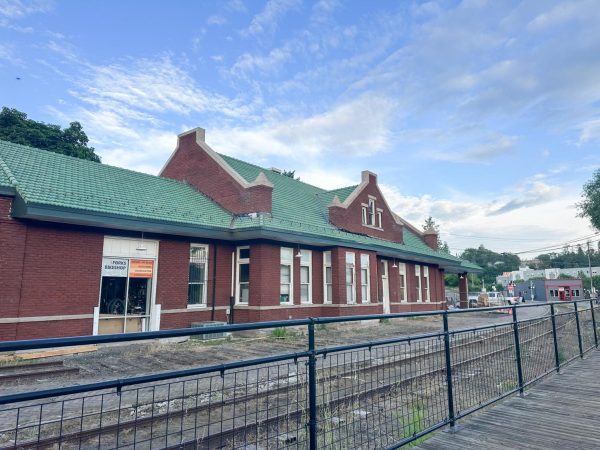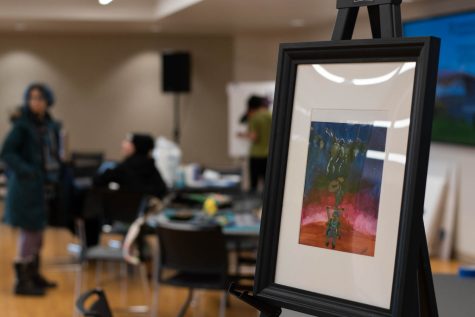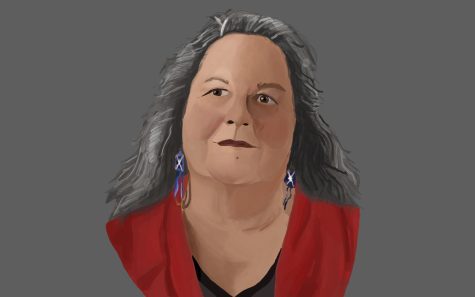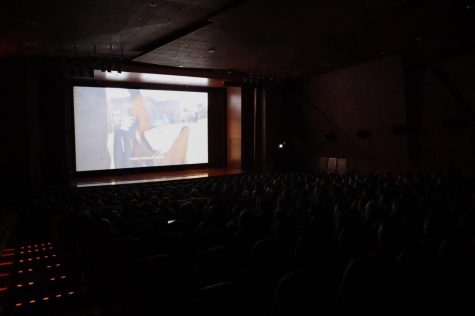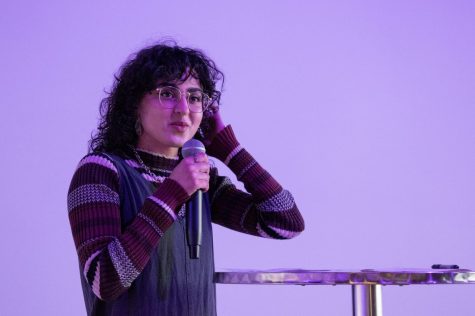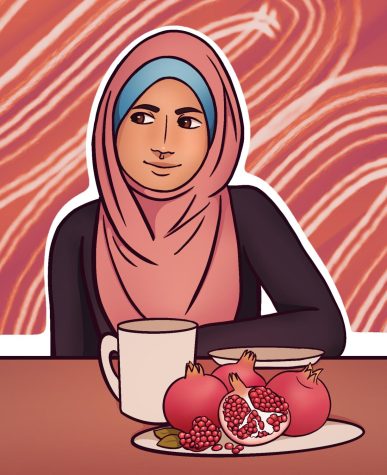A study in art: Museum of Art showcases graduate student work
One of Phil Mudd’s photos from his Master’s of Fine Arts exhibit on display at the WSU Museum of Art.
April 15, 2015
The Museum of Art Gallery is now home to sculpture installations, woven tapestries and photographs created with the intent of making the viewer question. This year’s Master of Fine Arts Thesis Exhibition is a collection of work from six students: Noelle Pflanz, Phil Mudd, Jade Lowder, Zachary Kolden, Kevin Leiter, and Sam Cannard.
Debby Stinson, marketing and public relations manager for the Museum of Art, said this year’s graduate candidates were exemplary. She said it’s rare when the museum is able to install an exhibit ahead of schedule, and this group of students did. Each student used the two-year program to create a variety of work to be considered for their Master’s degrees.
Noelle Pflanz
Noelle Pfalnz’ work, “This Can All Be Temporary,” was inspired by issues and questions she said she asks herself everyday about femininity, body image, marriage and relationships. Although she earned her undergraduate degree in printmaking, most of her work is done with textiles, fibers and yarns, she said.
“I was really interested in taking a very traditional feminine art form and trying to figure out how do I, as a young artist, still use those traditional feminine art forms but in a contemporary way,” Pflanz said.
Her work includes a 20-foot woven tapestry, embroidered shoes and bras, and a pair of flats hung by a thread from the ceiling, she said. The shoes just graze the floor of their display, and the air sifting through the gallery makes the shoes slowly spin on the spot, she said.
“They’re at this nice eye level so you can see all the little imperfections on the shoe from being worn for so long,” Pflanz said.
She said she has always dreamed about having her graduate degree and is very excited about moving on to the next step in her life.
“You have a lot of time to succeed and fail and keep learning from those lessons,” she said. “I think I’ve been waiting for this part of my life my entire life.”
Planz is now facing the questions of where to go and what to do next. Having so much independence and freedom has both positive and negative aspects and is what inspired the title of her work and her own personal mantra, “This is all temporary,” she said.
Phil Mudd
Phil Mudd presented his thesis through three photography collections titled “Window Shopping,” “Momento” and “Station.” The collection is circular. Wherever the viewer starts between the three collections the message should still follow the subject of people and objects, he said.
The viewer is following not only the people in the work but also the objects and what we put them through, Mudd said.
“It’s this cycle that we live in now that’s about commercialism and consumerism,” he said.
In “Window Shopping” an object is purchased by a person because it fulfills a purpose, and often it helps people define their identities, he said. Then in “Station” the object is serving its purpose in the person’s life, Mudd said. In “Memento” the object is abandoned, he said. He tried to picture abandoned objects in public places, he said. Often objects are abandoned in landfills or recycled or burned because people don’t like to see that part of the person and object cycle, Mudd said. He said his photos capture what he thinks people should see and think about.
Mudd started getting into photography in 2002, after he joined the army. His collection uses a mix of digital photography and traditional photography techniques, lenses and cameras, he said.
“With ‘Window Shopping’ in particular, the photo itself is actually a photo. It had to be processed. It’s not a pigment print,” Mudd said.
He said he hopes one of the messages people take away from his art is the importance of the everyday. People’s daily routines, interactions and gestures can really shape other people and the surrounding environment, he said.
Kevin Leiter
For his collection, Kevin Leiter was inspired by overlooked objects like light switches and plugs and how they go unnoticed until they’re needed. He was also inspired by minimalism and minimalist artists, he said.
His medium for this collection is screen printing and sculpture installation, including a raised floor where his work is placed in the exhibit, he said.
“It activates the environment, makes them aware that they’re stepping into this environment that’s separate from the rest of the gallery,” Leiter said.
He wants people to walk into the space and question his message, to question how they use mundane objects and how they think of them, he said. His work goes against preconceived notions about functional objects like electrical outlets, he said.
“A plug is no longer this functional object, because they’re screen prints and so obviously they have no functions, they exist in purely a visual form,” he said.
In looking to the future, Leiter said he has always had an interest in teaching. The screen printing community is tight-knit and a really interesting medium that few people understand, he said.
“Printmaking is a weird subject because it’s not like painting or sculpture. If you’re an artist and you tell someone you’re a painter they get it right away,” he said.
He said he hopes to spread the wealth and expose more people to the art of printmaking.
Jade Lowder
Jade Lowder presented a series of mixed media work in his collection. He said he is a painter first, and although there are other mediums in his work, he still considers all of them to be paintings.
“A lot of the stuff in the show has a structural element too,” Lowder said.
Lowder taught himself how to work with scaffolding and collaborated in learning drywall techniques with another student in order to complete some of his artwork. This structural element came into his work after he felt inspired by the urban cityscape of New York, he said. He visited New York City in February and kept a journal of observations, thoughts and feelings in different places in the city, Lowder said. When he got back he went through the journal and New York as a place strongly influenced his work from then on.
Lowder said he thinks places are a significant part of how we define ourselves. We tell people where we are from or where we want to go because it says something about ourselves, he said. He tried to capture the sense of place he felt in specific scenes of New York in his paintings, Lowder said. He said he hopes people will be able to relate to the scenes depicted even if they’ve never been to that exact street corner in New York, maybe they’re been to a street in a city that made them feel the same way.
Zachary Kolden
Zachary Kolden’s work, “Nature in a Pure State is Transparent,” looks at the interaction and similarities between art and science. Art and science share three important characteristics: collecting, observing, and speculating, he said. The subject of his art is often related to nature, he said.
“I always had an admiration for nature and being outside, it was always a very contemplative thing in my youth, a lot of thinking happened in that space and I think I relate to that space a lot more because of that,” Holden said.
His work features a lot of taxidermy because he said it helped him explore the construct of nature and also the role of the museum and how knowledge is dispersed or presented. He came to the program as a photographer and used that in his collection as well, he said.
“Because photography, when you think about it in a science and art context, a lot of it deals with observation, documentation, and interpretation of information,” Kolden said.
Kolden has always been a photographer, but he got the chance to explore different areas in grad school, like sculpture. Working on his thesis, he said he got to see where photography and sculpture overlapped and how a representation can change from a three dimensional space to a two dimensional space, he said.
“I wanted to go to grad school to push my work even further and get to understand my art practice,” Kolden said.
Sam Cannard
Ryan Hardesty, curator of Art and exhibitions, worked with Sam Cannard and the other MFA students to display their work.
“In her room-like installation of an imagined domestic interior, she brought together an array of materials and mediums,” Hardesty said in an email of Cannard’s work.
Cannard declined to be interviewed.
Stinson created informative interview handouts about each of the artists presented alongside the exhibit, Stinson said. In Cannard’s interview she spoke of representing the idea of home, how it is presented in culture and how it is in reality.
“Her choice of cardboard, a throw-away material with an inherent nod to make-shift shelters, speaks to the idea of “home” and it’s sometimes fragility,” Hardesty said.
Cannard worked well with the curatorial staff throughout the process of building the exhibit, he said.






